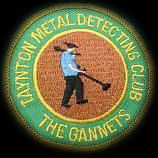
Taynton History
Parish History
The Dobunni
Roman Iron Making
Roman mosaic
Taynton Parva
St Lawrence Church
Glass Making
Brick Yard & Pottery
Brass Mill
WWII
Typhoon Crash
Hampden Crash
US Camp
US Finds
Taynton Metal Detecting Club
The Gannets
Roman Mosaic
|
In 2003 club members Don Sherratt and Dave Hutton were metal detecting when they noticed that a quantity of tessera lay on the surface of the field following some recent agricultural cultivations. On investigation it became evident that a Roman mosaic floor lay under the field and that part of it was still intact. The floor was quite badly damaged but enough remained to get a clear picture of how the floor would have looked about 1700 years ago. The general design is geometric with red and white diamond borders enclosing a series of large square panels. Only three whole square panels and part of a further three have so far been uncovered. The entire floor appears to have been surrounded by a wide border of red tesserae, but its full extent is unknown at present. Inside the panels are various designs. One panel has an eight-petalled flower surrounded by a circular guilloche (interwoven ribbon pattern border) made using red, white, grey and brown tesserae. In one of the corners of this panel there is a heart-shaped leaf. Another panel, though badly damaged, shows part of an icanthus (a type of two handled jug), |
|
|
|
After uncovering part of the floor the Gloucester Archaeology Department were informed and they have now taken over the supervision of the site. The department decided not to open up the floor any further at that stage due to funding constraints. They have examined and recorded it and steps were taken to make sure that no damage will be done to the site. A geophysical survey of the site showed many underground features and gave information on its layout and extent. Dave and Don contacted the Channel 4 programme Time Team about the site and they did a three day excavation in September 2007. Time Team found another mosaic floor but this was not opened up. At the end of filming an almost complete Roman tile/brick kiln was uncovered – still with soot, one of the best preserved kilns of its kind found in Britain. |
|
The floor was examined by one of Britain’s leading experts on Roman mosaics, Dr David Neal. Dr Neal described the floor as being large and of high status having been laid on a well prepared foundation. The floor consists of nine square panels. He believes the floor would have been in the main room of the villa surrounded by brightly painted walls and with a ceiling decorated on the theme of the floor design. An unusual feature is the use of four different coloured tessera, red, blue/grey, white and brown instead of the usual first three colours. The quality of the mosaics indicates that the site would have been occupied by a very wealthy Romano-British family. Many mosaic floors found in Gloucestershire are attributed to a mosaic workshop that operated in Cirencester. It is highly probable that this floor was produced by that workshop. |
|
Time Team Artist Impressions

|

|
Further Photographs
 Photographs of floor during excavated.
Photographs of floor during excavated.
|
 Photographs of dig and finds.
Photographs of dig and finds.
|


